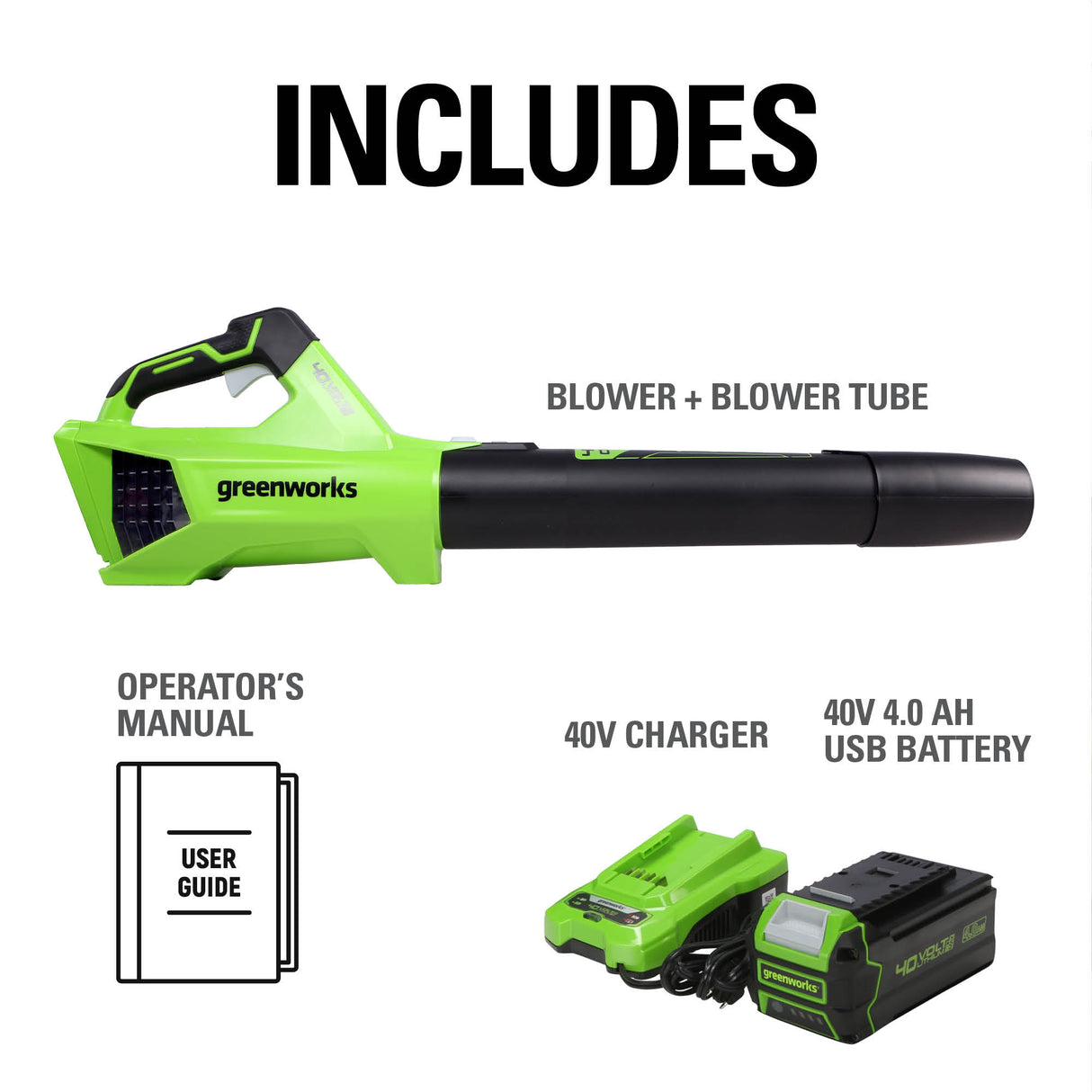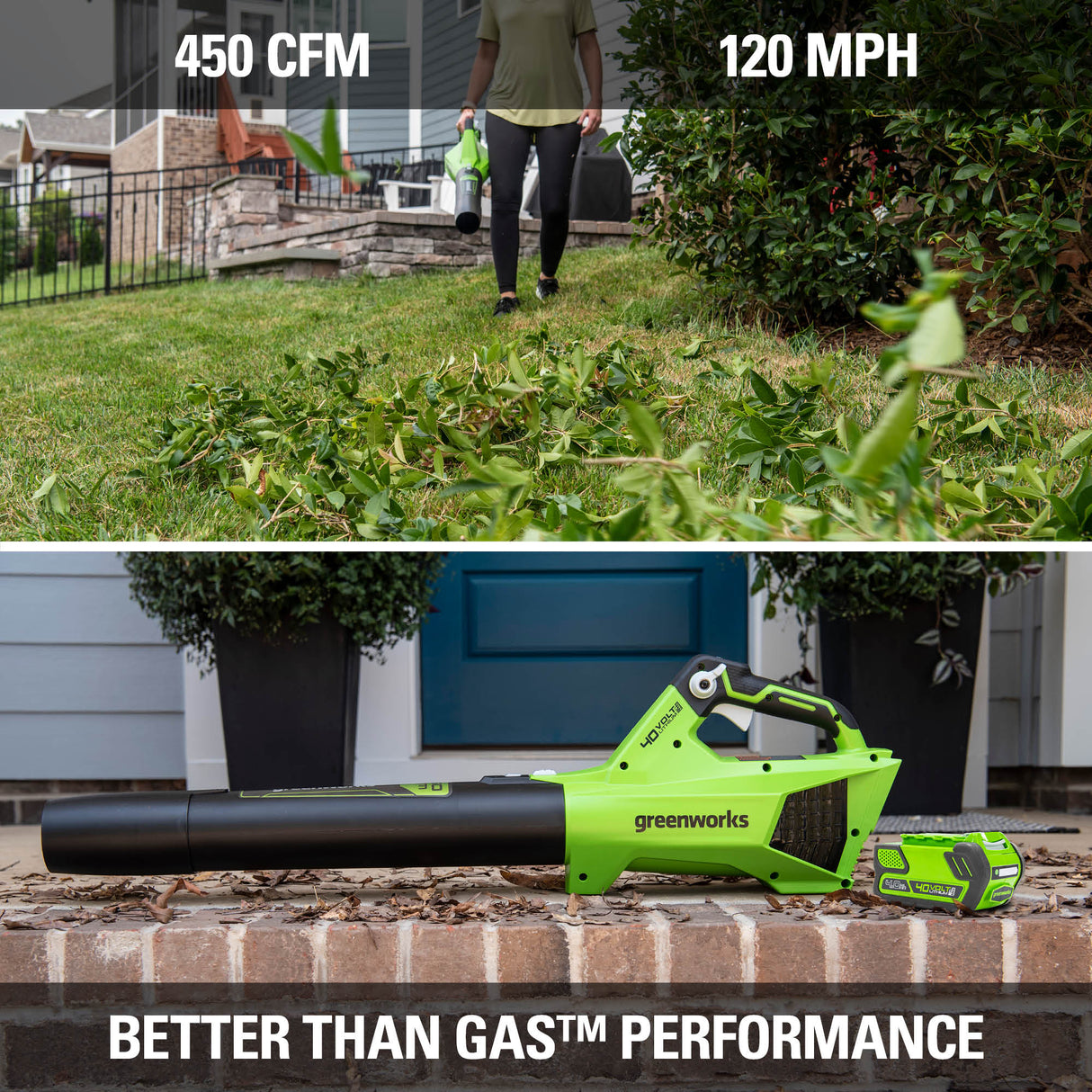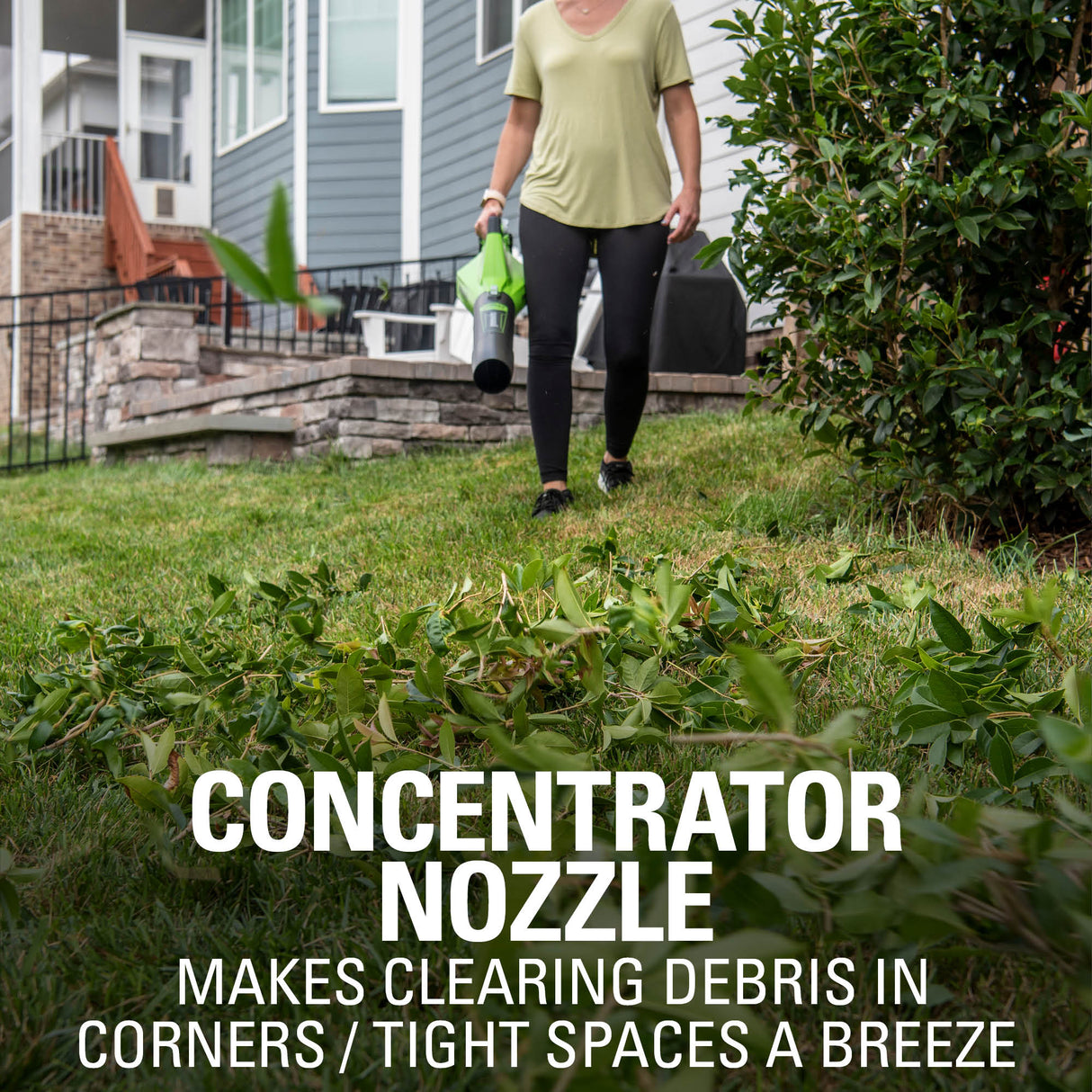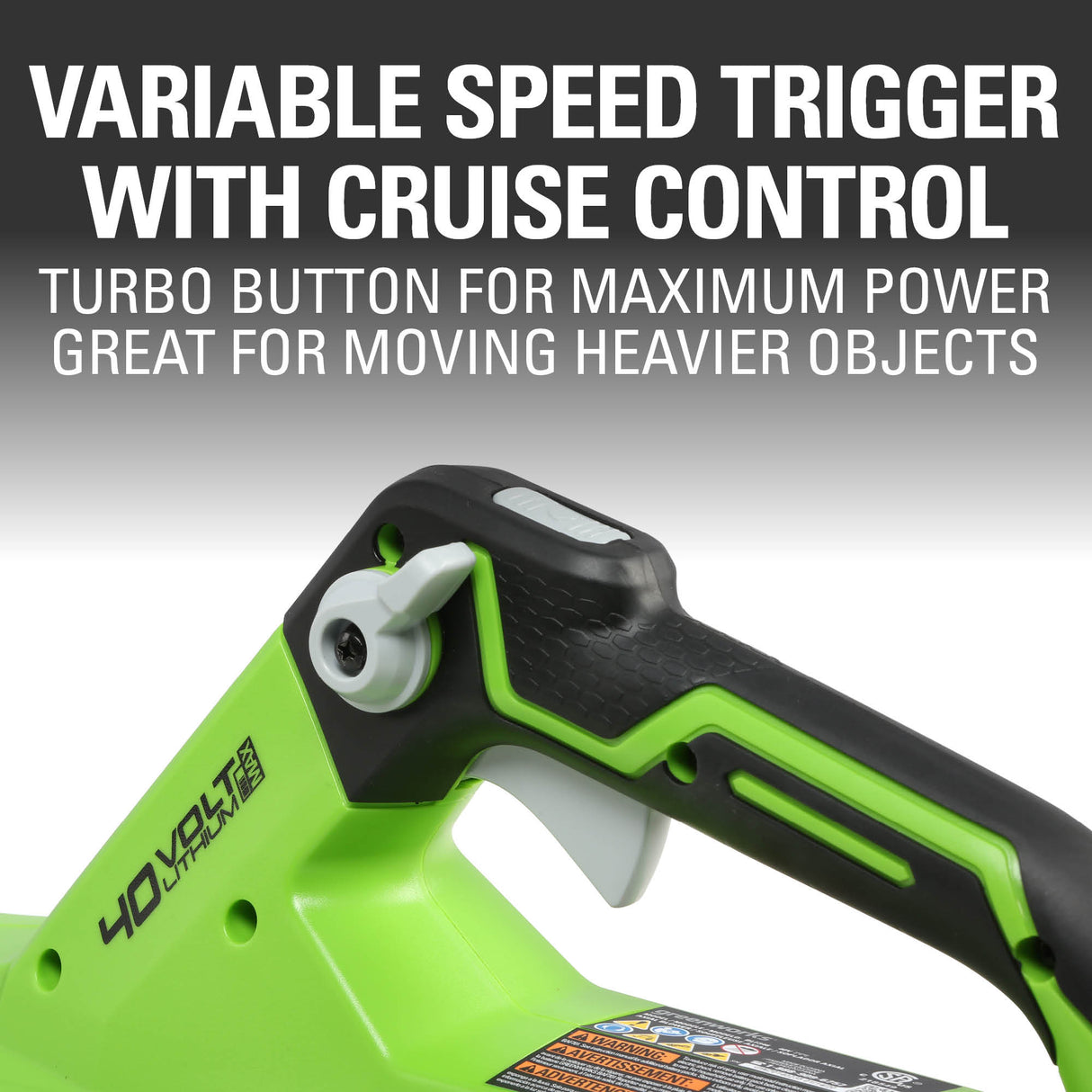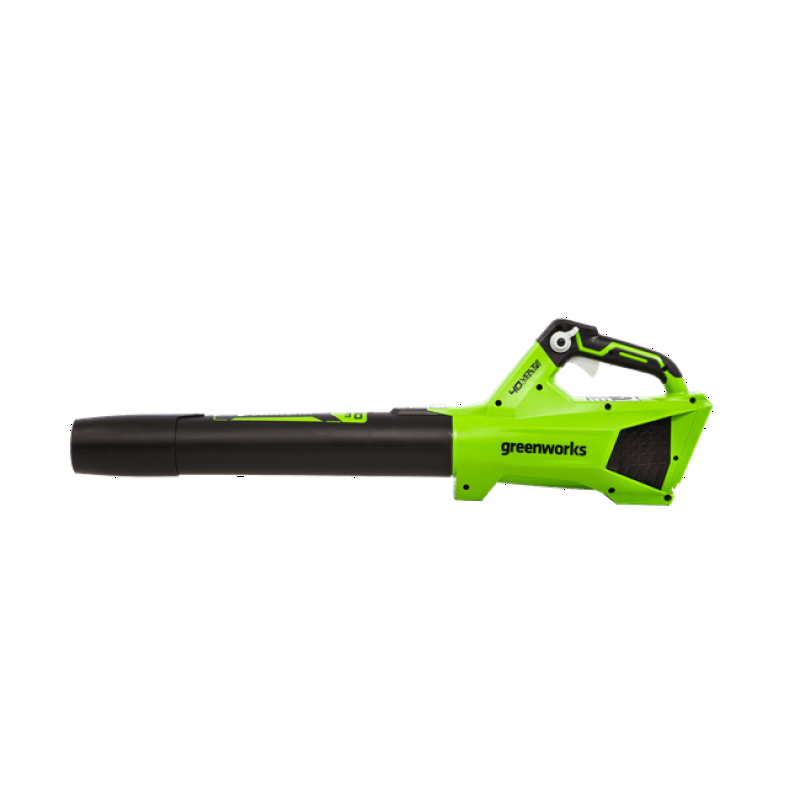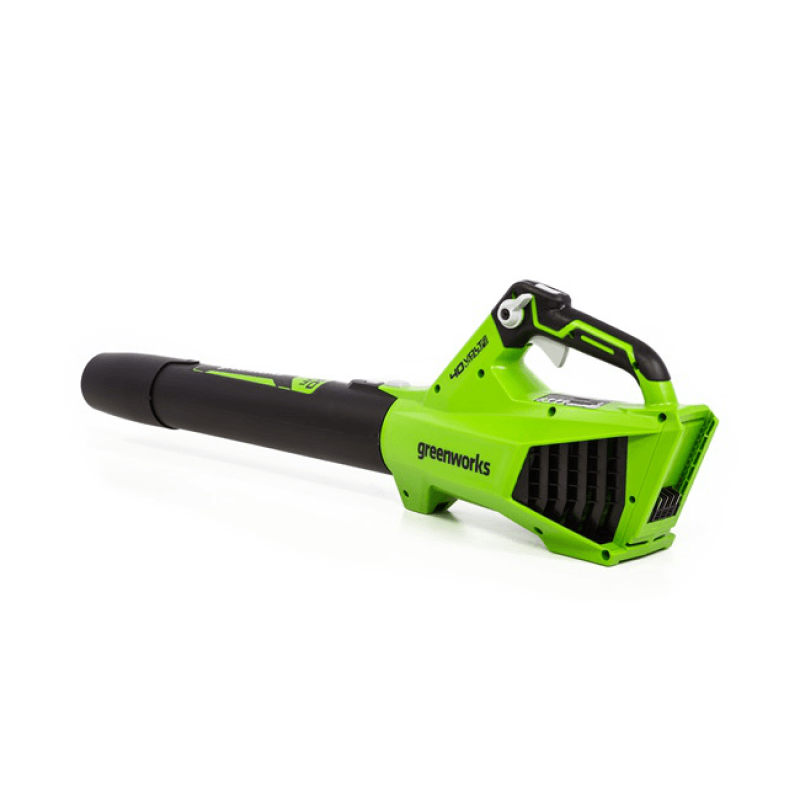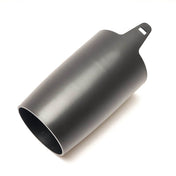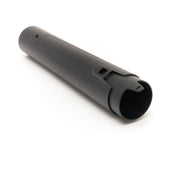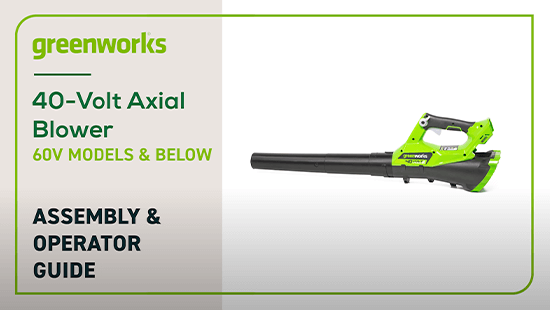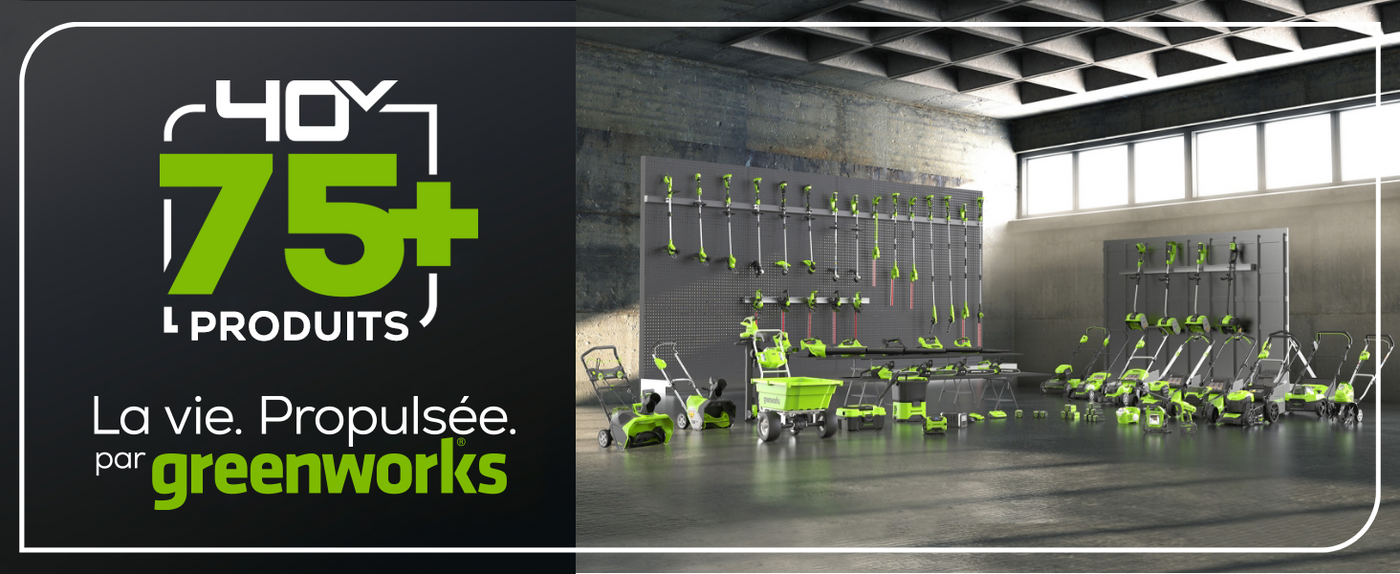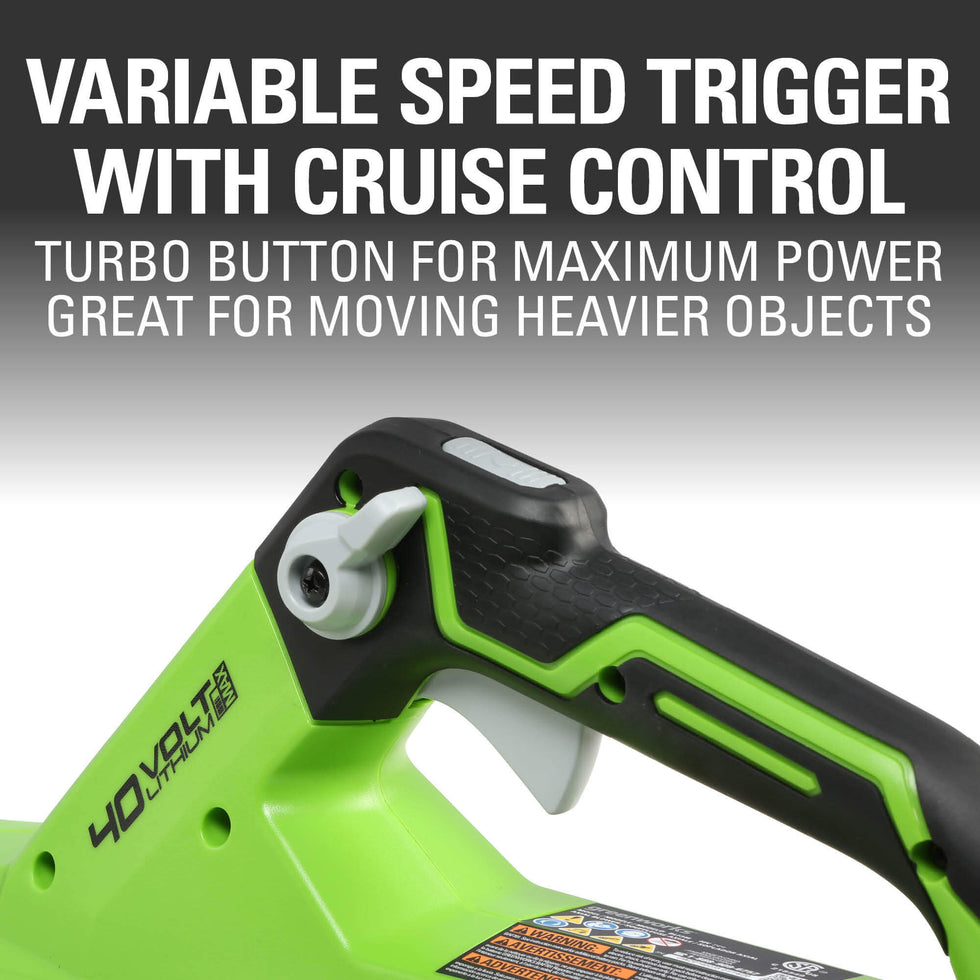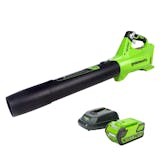Souffleur à feuilles sans balais 40 V, 120 MPH – 450 CFM (pi³/min), batterie 4,0 Ah et chargeur inclus
Garantie
Garantie

Compatible With :
Description
Description
Les outils électriques d'extérieur sans fil sont idéaux pour les propriétaires comme vous qui simplifient et se concentrent sur ce qui est essentiel pour tirer le meilleur parti de la vie. La famille d'outils Greenworks 40 V est construite avec une construction de poids moyen et des moteurs à haut rendement. La plate-forme lithium-ion Greenworks 40 V alimente plus de 40 produits d'extérieur, notamment des tondeuses, des souffleurs, des coupe-herbes, des scies à chaîne, des taille-haies et bien plus encore ! La batterie lithium-ion 40 V fournit la puissance dont vous avez besoin et offre une puissance sans décoloration et sans perte de mémoire après la charge. La plateforme Greenworks 40 V est livrée avec une garantie outil/batterie de 3 ans pour protéger votre investissement. De fabrication de haute qualité, ces produits sont faciles à démarrer et plus légers que les produits à gaz auxquels vous êtes habitué, ce qui rend votre journée de travail dans le jardin beaucoup plus facile. Parfaits pour les terrains allant jusqu'à ⅓ d'acre, les outils Greenworks 40 V sont légers, démarrent instantanément et ne nécessitent pratiquement aucun entretien – pas d'essence, pas d'huile, pas de gâchis – mais fournissent toujours une puissance semblable à celle du gaz.
Spécifications
Spécifications
-
Voltage40 V
-
Poids7,2 livres
-
Dimensions du produit assemblé36,4 po. × 7,2 po. × 10,5 po.
-
Dimensions de l'emballage18,7 po. × 7,6 po. × 10,8 po.
-
Poids du colis9,0 lb. (4,1 kg)
-
Temps de charge pour une batterie de 4,0 AhJusqu'à 120 minutes
-
Ampères-heures de la batterie4,0 Ah
-
Indicateur de batterieAffichage de charge sur la batterie
-
Chargeur inclusChargeur standard 2A
-
MoteurSans balais
-
Puissance nominale du moteur0,58 kW
-
Conception du souffleurAxial
-
Vitesse maximale de l'air (MPH)120 MPH (milles/heures)
-
Volume d'air maximum (CFM)450 CFM (pi³/min)
-
Gâchette à vitesse variable ?Oui
-
Bouton TurboOui
-
Régulateur de vitesseOui
-
Poignée rembourréeOui
-
Niveau de bruit à 50 pieds (longue portée)67 dB
-
Temps d'assemblage estimé≈ 15 minutes
-
Garantie3 ans de garantie
-
Batterie lithium-ion 40 V 4,0 Ah
-
Voltage40 V
-
Ampères-heures4Ah
-
Poids3,02 livres
-
Taille3,7 po. × 4 po. × 7,1 po.
-
Wattheures144
-
Temps de charge à 100 %À partir de 120 minutes
-
Cycles de vieJusqu'à 2000
-
Garantie3 ans de garantie
-
Chargeur 40 V
-
Voltage40 V
-
Poids2 livres
-
Taille6,5 po. × 8,3 po. × 3,7 po.
-
Temps de charge à 100 %À partir de 120 minutes
-
Temps de charge (batterie 2,0 AH)À partir de 60 minutes
-
Temps de charge (batterie 4,0 AH)À partir de 120 minutes
-
Garantie3 ans de garantie
-
Souffleur à feuilles 40 V 120 MPH - 450 CFM (Outil seulement)
-
Voltage40 V
-
Poids4,4 livres
-
Dimensions du produit assemblé36,4 po. × 7,2 po. × 10,5 po.
-
Dimensions de l'emballage18,7 po. × 7,6 po. × 10,8 po.
-
Poids du colis6,6 lb. (3 kg)
-
BatteriesNon incluses / Vendues séparément
-
MoteurSans balais
-
Puissance nominale du moteur0,58 kW
-
Conception du souffleurAxial
-
Vitesse maximale de l'air (MPH)120 MPH (milles/heures)
-
Volume d'air maximum (CFM)450 CFM (pi³/min)
-
Déclencheur à vitesse variable ?Oui
-
Bouton TurboOui
-
Régulateur de vitesseOui
-
Poignée rembourréeOui
-
Niveau de bruit à 50 pieds (longue portée)67 dB
-
Temps d'assemblage estimé≈ 15 minutes
-
Garantie3 ans de garantie
Manuels
Manuels
Comprend
Comprend
- 40V 450 CFM 120MPH Blower
- 40V 4.0Ah Battery
- 40V Charger
- Blower Tube
- Owner's Manual
Vidéos de produits
Foire aux questions
Foire aux questions
- Fabriquez-vous des souffleurs à gaz ?
- Un souffleur à feuilles à batterie est-il plus silencieux qu’un souffleur à essence ?
- Qu'est-ce qui est le plus important : MPH ou CFM (pi³/min) ?
- Quel est le souffleur le plus approprié pour ma propriété?
- Puis-je utiliser mon souffleur pour sécher ma voiture ou souffler la neige de mon entrée ?
- Quelle est la différence entre un souffleur à main et un souffleur à dos ?
- Comment utiliser la fonction déciquetage avec mon souffleur/aspirateur ?
- Pourquoi de la poussière sort-elle de mon sac de ramasse lorsque j'utilise mon souffleur ?
- Pourquoi mon aspirateur ne ramasse-t-il pas les débris de jardin ?
- Quel souffleur puis-je utiliser pour les surfaces dures ?
- Quelle est la durée de vie de la batterie et comment la maximiser ?
- Puis-je laisser ma batterie dans le chargeur après l'avoir chargée ?
- Pourquoi les batteries coûtent-elles beaucoup plus cher que l’outil ?
- Comment dois-je entreposer la batterie ? Puis-je laisser la batterie dans le garage ou dans la cabane ?
- Ma batterie est coincée dans mon outil. Comment la retirer ?
- Comment vérifier la charge de ma batterie ?
- Puis-je utiliser n’importe quelle batterie Greenworks dans n’importe quel outil Greenworks ?
- Existe-t-il certains outils qui ne peuvent pas accepter toutes les batteries de même voltage ?
- Est-ce que toutes les batteries de même voltage utilisent le même chargeur ?
- La température de la batterie est-elle importante ?
- Le chargeur indique que ma batterie est complètement chargée, mais je viens de l'utiliser et elle est épuisée. Pourquoi ne se charge-t-elle pas ?
- Mon chargeur clignote en rouge lorsque j'active ma batterie. Pourquoi cela se produit-il ?
- Mon chargeur a un voyant rouge fixe allumé lorsque j'active ma batterie. Que se passe-t-il ?
- Vos chargeurs sont-ils conçus pour des prises 220 V ou 120 V ?
Tous les souffleurs à feuilles Greenworks sont alimentés par batterie ou avec un fil électrique. Greenworks ne fabrique pas de modèles à essence.
Les souffleurs à feuilles électriques et à batterie sont en général plus silencieux que les modèles à essence. La puissance nominale dépend du modèle. Selon le jardin sur lequel vous avez l'intention de travailler, le flux d'air provenant de l'appareil peut également être un facteur primordial.
Le CFM et le MPH ont tous deux leurs avantages. Cela dépend du type de souffleur que vous recherchez. Le MPH est une abréviation de miles par heure. Cela indique la vitesse à laquelle l'air sort du souffleur. Des chiffres MPH plus élevés produisent de grandes variations de pression à l'entrée du souffleur. Par conséquent, un MPH plus élevé est bénéfique lors de l'examen des appareils de souffleur/aspirateur. Le MPH est généralement la statistique la plus importante ici, car une vitesse de l'air plus élevée permet de déplacer des débris plus lourds. Le CFM est une abréviation de pieds cubes par minute (pi³/min). Cela indique le volume d'air déplacé par le souffleur. Les appareils à CFM élevé ont tendance à déplacer de grands volumes d'air à des vitesses relativement faibles, ce qui permet de balayer et de nettoyer de grandes zones dans un temps contrôlé et plus court. Par conséquent, les souffleurs axiaux/souffleurs dédiés bénéficient davantage d'un CFM plus élevé et sont plus souhaitables pour ces appareils
En général, les souffleurs à feuilles électriques ont un CFM compris entre 200 et 400. Si votre propriété fait un acre ou plus, vous voudrez probablement un souffleur à feuilles avec un CFM compris entre 400 et 700 pi³/min
Nous ne recommandons pas d'utiliser ce souffleur pour une tâche autre que le soufflage de feuilles.
Les souffleurs à main sont souvent moins chers que les souffleurs à dos. Ils ont des moteurs plus petits pour garantir qu'ils ne sont pas trop lourds à transporter. Comme le moteur est plus petit, ils ont moins de puissance. Ces souffleurs sont parfaits si vous avez une petite cour, mais peuvent être éprouvants si vous passez 30 à 40 minutes sur le travail. Les souffleurs à dos fournissent plus de puissance et vous pouvez les transporter partout où vous allez. Ils ont l'avantage supplémentaire d'être plus ergonomiques puisque vous ne comptez pas uniquement sur la force des bras. Les souffleurs à dos sont plus adaptés aux gros travaux, mais ils sont également plus chers que le souffleur à main
Lors du broyage des feuilles, le souffleur/aspirateur doit être en mode TURBO-MULCH. Les éléments tels que les petites feuilles et les brindilles seront broyés lorsqu'ils passeront à travers le boîtier du ventilateur. Nous recommandons de vider le sac après chaque utilisation pour éviter toute détérioration et obstruction du flux d'air, ce qui réduira les performances du déchiqueteur .
Le sac de ramasse Greenworks est doté de petits trous nécessaires au fonctionnement du sac de ramasse. Ceux-ci permettent le passage de très petites particules de poussière.
Si votre souffleur ne ramasse pas facilement les feuilles, assurez-vous que la buse est suffisamment proche des feuilles. Assurez-vous également que l'indicateur de mode est sur le bon réglage. Appuyez sur l'interrupteur bas/haut pour augmenter les options de vitesse. La conception unique du souffleur-aspirateur signifie que seuls les objets légers et de faible densité tels que les feuilles et les débris de jardin seront ramassés. Il convient de noter que les objets de densité plus élevée tels que les pierres et les bâtons ne seront pas ramassés. Si vous constatez que l'appareil ne ramasse toujours pas, il peut être nécessaire de retirer le tube du souffleur ou les tubes de déchiquetage pour dégager un tube ou une turbine obstruée. Assurez-vous de retirer la batterie ou de débrancher l'appareil avant de vérifier le tube ou la turbine.
La meilleure puissance de poussée pour éliminer les matières organiques lourdes ou humides des surfaces molles comme l'herbe, la terre ou le sable proviendra d'un souffleur électrique filaire ou de nos souffleurs 80V PRO. Le souffleur à dos sans balais 80V 580 CFM (pi³/min), avec jusqu'à 580 CFM (pi³/min) à 145 ou le souffleur axial sans fil sans balais 80V 500 CFM (pi³/min) avec jusqu'à 500 CFM (pi³/min) de débit d'air, les deux unités offrent plus de CFM (pi³/min)
Pour tirer le meilleur parti de votre batterie, vous devez la retirer du chargeur une fois la charge terminée. Le problème de la surcharge est qu'elle peut endommager la batterie, ce qui peut réduire sa durée de vie et vous laisser dans l'embarras si elle s'arrête au milieu d'un projet.
Les chargeurs de batterie sont dotés d'un dispositif d'arrêt automatique pour éviter toute surcharge. Cependant, nous conseillons aux clients de retirer la batterie du chargeur une fois qu'elle est complètement chargée et de débrancher également le chargeur de la prise, car il s'agit d'une bonne pratique de sécurité électrique. Cela permettra également d'éviter les fausses lectures de défauts et permettra au chargeur de se réinitialiser à chaque fois qu'il est utilisé pour charger une batterie.
La batterie est le composant le plus important d'un appareil à batterie. Soyez assuré que nous fixons le prix de nos batteries en tenant compte du coût des matériaux, de la fabrication et des prix actuels du marché. Les batteries sont les éléments les plus coûteux à fabriquer et à expédier dans n'importe quel ensemble. Les ensembles complets comprenant un outil, une batterie et un chargeur sont proposés à un prix abordable afin que les consommateurs puissent commencer à construire cette gamme d'outils et passer à l'achat d'appareils contenant uniquement des outils. Lorsque vous achetez des batteries seules, le coût qu'elles entraînent est plus important.
Lorsque la batterie n'est pas utilisée, nous vous suggérons de la entreposer à l'intérieur, dans un endroit frais et sec, à l'abri de la lumière directe du soleil. Laissez le chargeur débranché et la batterie déconnectée du chargeur, sauf si elle doit être rechargée. Il est recommandé d'entreposer la batterie complètement chargée et, si elle est entreposée pendant une période où aucune utilisation n'est prévue, de vérifier la charge tous les deux mois. Si vous remarquez que la charge a baissé, nous vous conseillons de recharger complètement la batterie avant de la remettre dans son lieu d'entreposage sûr. En suivant ces étapes, vous vous assurerez de tirer le meilleur parti de la durée de vie de la batterie.
Produits 60 V / 80 V : Pour retirer la batterie, appuyez sur le bouton de déverrouillage de la batterie et maintenez-le enfoncé. Ensuite, retirez la batterie en tirant dessus. Dans certains cas, si les ressorts situés en dessous se sont bloqués, vous devrez peut-être appuyer légèrement sur le haut de la batterie pour les réengager et aider la batterie à sortir. La batterie s'insère parfaitement dans le produit pour éviter tout délogement accidentel pendant l'utilisation ; il peut être nécessaire de tirer fort pour la retirer. Avant utilisation, assurez-vous que les rails de la batterie et du produit sont exempts de débris qui pourraient coincer la batterie. Produits 24 V/40 V : Pour retirer la batterie, appuyez sur le bouton de verrouillage de la batterie et maintenez-le enfoncé. Retirez la batterie de la poignée. La batterie s'insère parfaitement dans le produit pour éviter tout délogement accidentel pendant l'utilisation ; il peut être nécessaire de tirer fort pour la retirer. Avant utilisation, assurez-vous que les rails de la batterie et du produit sont exempts de débris qui pourraient coincer la batterie.
Appuyez sur le bouton indicateur de capacité de la batterie (BCI) situé à l'extrémité de la batterie. Les voyants s'allumeront en fonction du niveau de capacité de la batterie. Veuillez noter que cet interrupteur nécessite une pression directe et ferme du bout du doigt. Si le bouton n'est pas complètement enfoncé, les voyants ne s'allumeront pas. Veuillez également noter que les voyants ne restent allumés que quelques secondes et s'éteignent automatiquement. Une autre raison pour laquelle les voyants ne s'allument pas est que la batterie est complètement déchargée et doit être rechargée.
Nos batteries sont interchangeables uniquement avec des outils de la même plateforme de voltage. La différence entre les batteries de même voltage est la capacité en ampères-heures (Ah). Plus la capacité en ampères-heures (Ah) de la batterie est élevée, plus elle offre d'autonomie.
Il existe quelques exceptions. • Nos modèles de souffleuses à neige 80 V 20 po 2600402 / 2605202 / 2601302 fabriqués avant septembre 2017 ne peuvent utiliser que des modèles de batterie de 2,0 Ah ou 2,5 Ah. • Notre modèle de batterie 60 V 8,0 Ah 2957102 ne peut pas être utilisé dans les outils suivants en raison de la hauteur : tondeuses à double port, laveuses à pression ou aspirateur à déchets sec/humide.
Oui, c'est le cas. Chaque gamme de produits dispose de modèles de chargeurs spécifiques qui peuvent charger toutes les batteries de cette plateforme de voltage, quelle que soit leur capacité en Ah.
La température de la batterie avant utilisation ne doit pas être trop élevée ou trop basse. Pour les souffleuses à neige, si la batterie est trop froide, elle risque de ne pas fonctionner. Laissez la batterie atteindre la température ambiante avant utilisation. Pour nos autres outils, laissez la batterie refroidir avant utilisation si elle est trop élevée. Pour éviter les problèmes de température de la batterie, les batteries doivent être gardées à l'intérieur dans un endroit sec et frais. Les informations sur l'entreposage et la température de la batterie se trouvent dans votre manuel d'instructions.
Placer une batterie qui vient d'être utilisée sur le chargeur entraîne souvent un faux signal de charge complète. Retirez la batterie du chargeur et laissez-la reposer dans une zone à température ambiante pendant environ 10 à 15 minutes avant de la charger.
Lorsque la batterie est insérée dans le chargeur et que le voyant d'état clignote en rouge, retirez la batterie du chargeur pendant 1 minute, puis réinsérez-la. Si le voyant d'état clignote en vert, la batterie se charge correctement. Si le voyant d'état clignote toujours en rouge, retirez la batterie et débranchez le chargeur pendant 1 minute. Après 1 minute, branchez le chargeur et réinsérez la batterie. Si le voyant d'état clignote en vert, la batterie se charge correctement. Si le voyant d'état clignote toujours en rouge, cela indique probablement un problème avec la batterie ou le chargeur et doit être résolu soit par notre équipe de garantie, soit par remplacement.
Cela indique généralement que la batterie n'est pas à la bonne température pour être chargée. Laissez la batterie et le chargeur reposer à l'intérieur à température ambiante jusqu'à ce qu'ils ne soient plus chauds/froids et essayez de les charger à nouveau.
Les chargeurs Greenworks vendus aux États-Unis et au Canada sont conçus pour être utilisés uniquement sur des prises 120 V.



